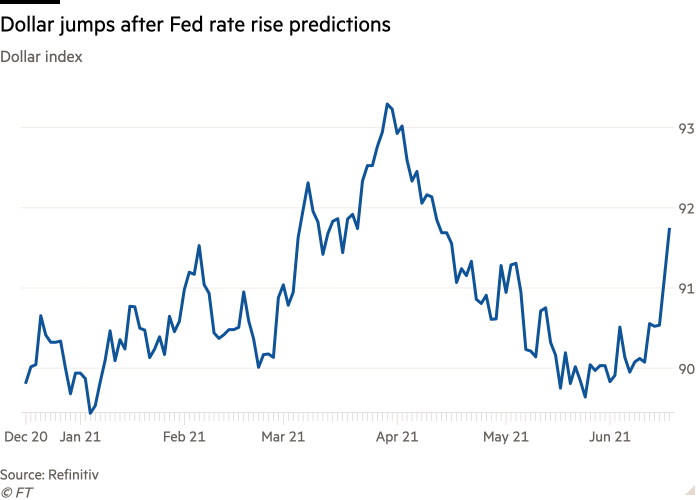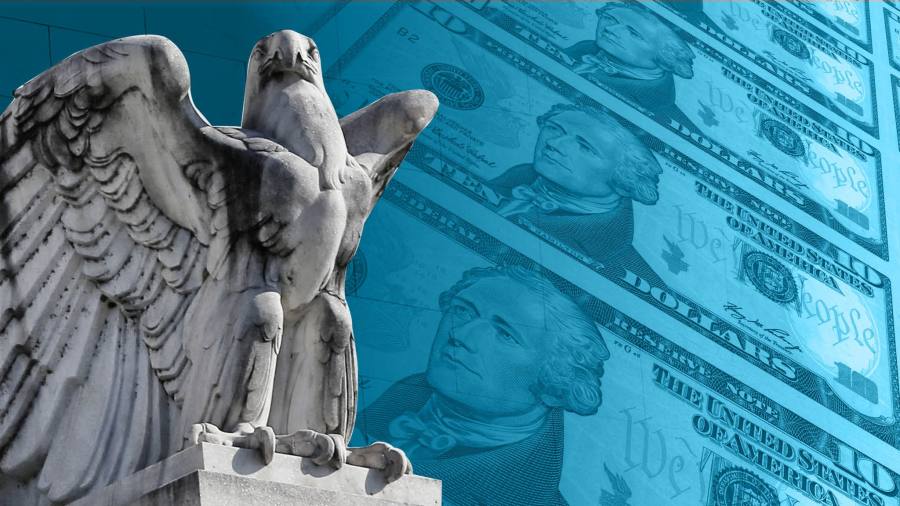The greenback was heading for its largest two-day acquire of the yr after US central financial institution officers introduced ahead the anticipated timing of the Federal Reserve’s first post-pandemic rate of interest rise.
The greenback index, which measures its worth towards a basket of different main currencies, jumped 0.7 per cent after gaining nearly 0.6 per cent on Wednesday. The euro misplaced 0.5 per cent towards the greenback to $1.193, taking the US foreign money’s acquire over its eurozone counterpart to 1.5 per cent over two buying and selling classes.
The Federal Reserve mentioned on Wednesday that almost all of its officers anticipated a rate rise in 2023, towards earlier predictions of 2024, because the US financial system recovered strongly from the pandemic and shopper value inflation hit an annual price of 5 per cent in Could. In a broadly anticipated transfer, Fed chair Jay Powell additionally mentioned the world’s most influential central financial institution was “speaking about speaking about” lowering the Fed’s $120bn-a-month asset purchases which have boosted monetary markets since March 2020.
“The greenback response has been disproportionate,” mentioned Brian Nick, chief funding strategist at asset supervisor Nuveen. “I really feel there was simply some huge cash behind that commerce ready for a set off,” he added, after the greenback index had barely moved for weeks as merchants waited on rate of interest clues.
Traders largely anticipate the Fed to start discussions on lowering assist later this summer season, with the main target shifting to additional potential indicators from world policymakers’ Jackson Gap summit in August. Brian Rose, chief economist at UBS World Wealth Administration, believes the central financial institution will give market individuals “loads of warning”, and search to wrap up the so-called taper course of earlier than elevating rates of interest.
Inventory markets stayed close to current all-time highs as traders targeted extra on the US central financial institution having raised its outlook for financial progress.

Wall Road’s blue-chip S&P 500 share index was flat in early New York dealings after falling 0.5 per cent on Wednesday. The technology-focused Nasdaq Composite index rose 0.3 per cent. The Stoxx Europe 600 was additionally flat.
However the change in Fed policymakers’ price rise projections additionally jolted the US Treasury market on Wednesday, prompting follow-on falls in European authorities bonds within the subsequent session.
The yield on the benchmark 10-year Treasury observe jumped 0.09 proportion factors on Wednesday night to 1.58 per cent following the US central financial institution’s assertion, reflecting a drop in costs. But it surely moderated barely in European buying and selling hours to 1.557 per cent.
European bond yields rose on Thursday as merchants guess on different central banks following the Fed to rein of their crisis-era stimulus spending. The UK’s 10-year gilt yield jumped 0.07 proportion factors to 0.828 per cent. Germany’s equal Bund yield added 0.03 proportion factors to minus 0.164 per cent.
The Fed nailed it — however its policymakers can’t see the longer term, and neither are you able to

In Unhedged, Robert Armstrong dissects a very powerful market tendencies and discusses how Wall Road’s greatest minds reply to them. Join here to get the e-newsletter despatched straight to your inbox each weekday
Inventory market reactions have been muted, analysts mentioned, as a result of fairness traders have been assured that improved US financial progress would raise firms’ earnings.
The subsequent US price rise “might be occurring at a time when the [global] financial system is ready to stand on its ft”, mentioned Zehrid Osmani, supervisor of Martin Currie’s world portfolio belief.
If Fed officers had caught to anticipating the subsequent price rise as late as 2024, Osmani added, “there could be extra to fret about as we could possibly be liable to [the US economy] overheating”.
Juliette Cohen, strategist at CPR Asset Administration, warned fairness traders have been exhibiting “complacency” about inflation, which might erode firms’ earnings in the event that they have been unable to move greater enter prices on to their prospects. If firms highlighted such issues of their upcoming second-quarter incomes statements, Cohen mentioned, “the constructive temper in fairness markets . . . will come into query”.







